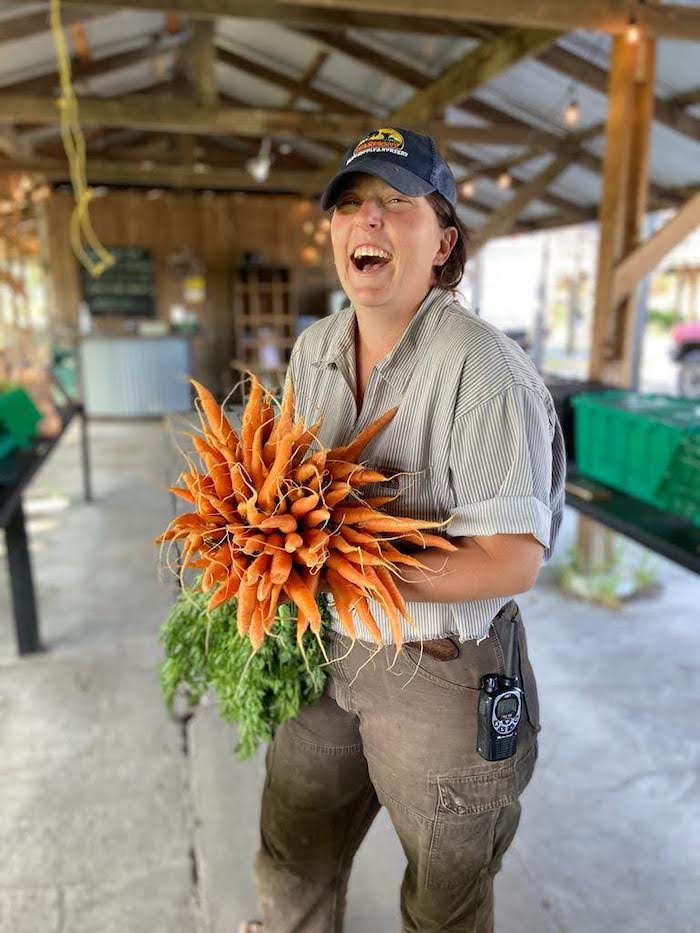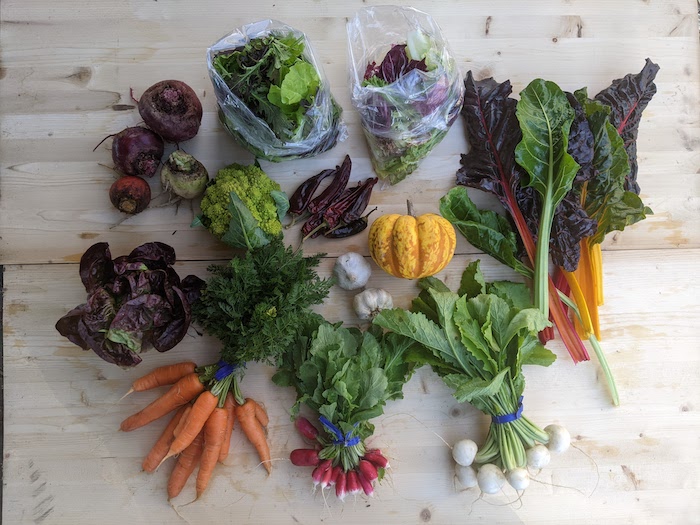 Winter Sister Farm is owned and run by sisters Anna and Sarah Dozor, with the invaluable help of sole employee Kate Beilharz. Focused on feeding people during the typical off-season for many other farms, they distribute food from December through May. Winter Sister grows storage crops like potatoes and onions, as well as cool-weather crops that can be harvested fresh through mild winters and springs: lettuce, broccoli, kale, baby greens, etc. They also raise a small flock of sheep for wool and meat and sell shares of lamb. The farm is in its second year of production and is located in south Sebastopol.
Winter Sister Farm is owned and run by sisters Anna and Sarah Dozor, with the invaluable help of sole employee Kate Beilharz. Focused on feeding people during the typical off-season for many other farms, they distribute food from December through May. Winter Sister grows storage crops like potatoes and onions, as well as cool-weather crops that can be harvested fresh through mild winters and springs: lettuce, broccoli, kale, baby greens, etc. They also raise a small flock of sheep for wool and meat and sell shares of lamb. The farm is in its second year of production and is located in south Sebastopol.
Describe a typical day on your farm.
As with all farms, there is really no typical day. This is what a day might look like right now, in mid-September, when we are in a dance between the big harvests of storage crops that are coming in, the field prep and planting for all the winter hardy crops that are going out, and whatever amount of weeding we can manage on the side:
We start at 8am. Yesterday was a big planting of overwintering brassicas, so Kate and Anna laid a bunch of drip tape while Sarah spaded and shaped a few last beds, and then we planted together until lunch. After lunch, we cultivated an earlier planting and ended the day thinning beets.
Kate leaves at 4:30; Anna and Sarah will generally work for a few more hours. Yesterday Anna processed the last of our garlic and got some peppers into the dehydrator, and Sarah worked on irrigation and got the tractor set up for potato harvest. Anna checks on the sheep again each evening, Sarah closes the greenhouse and does a little bookkeeping.
Name three unexpected sensory delights of farming.
The feeling of sinking your hands into fluffy but moist soil when the tilth is perfect.
The sound of the corn rustling.
The sight, sound, and feel on the tractor when the soil moisture is right for spading and there’s no dust and the spader is easing through without clanging or jolting.
 Of which sustainable or environmental practices are you most proud?
Of which sustainable or environmental practices are you most proud?
Our small flock of sheep are integral to our land management practices. They allow us to reduce mowing, lower fire risk, and add crucial nutrition back into the soil. Anna manages the main flock on an intensive rotational grazing schedule, moving them every one-to-five days to maximize carbon sequestration in the grass roots and soil. They also graze our cover crop and crop residue once we’ve finished harvesting.
Overall, we hope that by growing a wide variety of hearty foods to fill people’s bellies in the winter and spring, we’re offering food with a shorter supply chain and lower transport cost to our local community, especially folks who love eating locally but might find themselves buying food from farther away in the winter.
If you could change one thing about the food industry, what would it be, and why?
The way that farming is subsidized/funded in the U.S. The subsidies that go into large commodity crop farms are nowhere to be found in the community scale ecological farms that we want for our future.
We came to farming with a ton of privilege: land access and, thus, low startup costs and the ability to have worked in agriculture for low wages for years to gain the experience needed to start our own business. All of this is completely unrealistic for the vast majority of farmers, especially BIPOC farmers. We need large-scale, governmental funding to help bridge this gap, more accessible loans and grants, and expanded community land trusts to keep farmland affordable, equitable, and secure.
What is your greatest challenge as a farmer?
Anna says money and Sarah says communication. Both have to do with how little extra space there is in farming for the practices that are crucial for long-term success: good communication, engaging your core when lifting, thinking deeply about the bigger picture, and solving the impossible math problem of how to pay ourselves appropriately for this work while charging an accessible price for our food.
 When you’re not farming, what are you doing?
When you’re not farming, what are you doing?
Kate climbs and does acrobatic silks and is taking prerequisite classes for a graduate program in counseling. Anna goes to the movies, reads books, and picks out wallpaper for her tiny house. Sarah writes, goes for walks with her dog, and tries to sit around drinking beers with whomever will sit around with her. We all try to get into water as much as possible, and we all cook a lot (in the summer we eat from West County Community Farm’s incredible bounty).
Where can people find your products?
Our main focus is our CSA program. CSA members pick up weekly free-choice vegetable shares every week from December through May. We still have CSA memberships available; you can find more information on our website (wintersisterfarm.com). We have multiple share sizes, a Community Support Fund that allows those with more resources to support those for whom the cost is prohibitive, and we also sell à la carte items during our CSA pickup and farmstand hours:
Tuesdays 2-6pm, Saturdays 10am-2pm, December-May, 1670 Cooper Road, Sebastopol.
Photos: Felicja Channing
